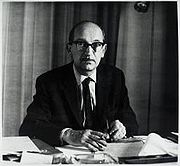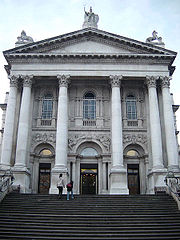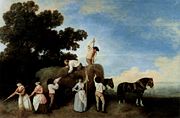
Norman Reid (museum director)
Encyclopedia

Tate
-Places:*Tate, Georgia, a town in the United States*Tate County, Mississippi, a county in the United States*Táté, the Hungarian name for Totoi village, Sântimbru Commune, Alba County, Romania*Tate, Filipino word for States...
from 1964 to 1979
Early life
Norman Reid was born in DulwichDulwich
Dulwich is an area of South London, England. The settlement is mostly in the London Borough of Southwark with parts in the London Borough of Lambeth...
, London
London
London is the capital city of :England and the :United Kingdom, the largest metropolitan area in the United Kingdom, and the largest urban zone in the European Union by most measures. Located on the River Thames, London has been a major settlement for two millennia, its history going back to its...
, and was the son of a shoemaker. He was educated at Wilson's Grammar School and won a scholarship to the Edinburgh College of Art
Edinburgh College of Art
Edinburgh College of Art is an art school in Edinburgh, Scotland, providing tertiary education in art and design disciplines for over two thousand students....
, where he studied in the late 1930s and was taught by William Gillies
William Gillies
William Gillies was a Scottish patriot and a socialist. He helped to form the Scots National League which joined with in other bodies to form the National Party of Scotland which in turn evolved into the Scottish National Party ....
. Later, he took a degree in English at Edinburgh University. Reid enlisted in 1939 in the Argyll and Sutherland Highlanders
Argyll and Sutherland Highlanders
The Argyll and Sutherland Highlanders, 5th Battalion The Royal Regiment of Scotland is an infantry battalion of the Royal Regiment of Scotland....
at the start of Second World War
World War II
World War II, or the Second World War , was a global conflict lasting from 1939 to 1945, involving most of the world's nations—including all of the great powers—eventually forming two opposing military alliances: the Allies and the Axis...
. He was commissioned as a second lieutenant
Second Lieutenant
Second lieutenant is a junior commissioned officer military rank in many armed forces.- United Kingdom and Commonwealth :The rank second lieutenant was introduced throughout the British Army in 1871 to replace the rank of ensign , although it had long been used in the Royal Artillery, Royal...
in the same regiment on 2 August 1941. He transferred to the Royal Artillery
Royal Artillery
The Royal Regiment of Artillery, commonly referred to as the Royal Artillery , is the artillery arm of the British Army. Despite its name, it comprises a number of regiments.-History:...
on 1 November 1941, and later served in Italy
Italy
Italy , officially the Italian Republic languages]] under the European Charter for Regional or Minority Languages. In each of these, Italy's official name is as follows:;;;;;;;;), is a unitary parliamentary republic in South-Central Europe. To the north it borders France, Switzerland, Austria and...
. He left the Army
British Army
The British Army is the land warfare branch of Her Majesty's Armed Forces in the United Kingdom. It came into being with the unification of the Kingdom of England and Scotland into the Kingdom of Great Britain in 1707. The new British Army incorporated Regiments that had already existed in England...
in 1946 with the rank of major. In 1941 he married Jean Lindsay Bertram, whom he met while they were students at the Edinburgh College of Art.
Tate gallery

Tate
-Places:*Tate, Georgia, a town in the United States*Tate County, Mississippi, a county in the United States*Táté, the Hungarian name for Totoi village, Sântimbru Commune, Alba County, Romania*Tate, Filipino word for States...
Gallery in 1946 having heard that it was under-staffed, and became the right-hand man of the then Director, John Rothenstein
John Rothenstein
Sir John Knewstub Maurice Rothenstein CBE was an English art historian. He grew up in London the son of Sir William Rothenstein. The family was loosely connected to the Bloomsbury Set. John Rothenstein studied at Oxford University and became friends with T. E. Lawrence...
, becoming deputy director in 1954 and keeper in 1959. He was appointed Director when Rothenstein retired in 1964.
A much needed expansion of the Gallery, the 'North East Quadrant', was built in 1979 during Reid's directorship, vastly increasing the Tate's exhibition space. Reid also strengthened the Collection, especially in the area of early twentieth-century European art, acquiring outstanding works by artists including Pablo Picasso
Pablo Picasso
Pablo Diego José Francisco de Paula Juan Nepomuceno María de los Remedios Cipriano de la Santísima Trinidad Ruiz y Picasso known as Pablo Ruiz Picasso was a Spanish expatriate painter, sculptor, printmaker, ceramicist, and stage designer, one of the greatest and most influential artists of the...
, Giacometti, Henri Matisse
Henri Matisse
Henri Matisse was a French artist, known for his use of colour and his fluid and original draughtsmanship. He was a draughtsman, printmaker, and sculptor, but is known primarily as a painter...
, Constantin Brâncuşi
Constantin Brancusi
Constantin Brâncuşi was a Romanian-born sculptor who made his career in France. As a child he displayed an aptitude for carving wooden farm tools. Formal studies took him first to Bucharest, then to Munich, then to the École des Beaux-Arts in Paris...
, Piet Mondrian
Piet Mondrian
Pieter Cornelis "Piet" Mondriaan, after 1906 Mondrian , was a Dutch painter.He was an important contributor to the De Stijl art movement and group, which was founded by Theo van Doesburg. He evolved a non-representational form which he termed Neo-Plasticism...
, and Salvador Dalí
Salvador Dalí
Salvador Domènec Felip Jacint Dalí i Domènech, Marquis de Púbol , commonly known as Salvador Dalí , was a prominent Spanish Catalan surrealist painter born in Figueres,Spain....
. During Reid's Directorship the Tate staged a number of ground-breaking exhibitions, including an early presentation of Gilbert and George
Gilbert and George
Gilbert & George are two artists who work together as a collaborative duo. Gilbert Proesch and George Passmore have become famous for their distinctive, highly formal appearance and manner and their brightly coloured graphic-style photo-based artworks.-Early life:Gilbert Proesch was...
's Living Statues.
In 1972 the Tate purchased Equivalent VIII
Equivalent VIII
Equivalent VIII, usually referred to as "The Bricks", is the last and most famous of a series of minimalist sculpture by Carl Andre. Constructed in 1966, it was bought by The Tate Gallery in 1972. The exhibit comprises one-hundred-and-twenty fire bricks, arranged in two layers, in a six-by-ten...
, a 1966 work by American
United States
The United States of America is a federal constitutional republic comprising fifty states and a federal district...
sculptor Carl Andre
Carl Andre
Carl Andre is an American minimalist artist recognized for his ordered linear format and grid format sculptures. His sculptures range from large public artworks to more intimate tile patterns arranged on the floor of an exhibition space Carl Andre (born September 16, 1935) is an American...
which consisted of a stack of 120 ready-made fire bricks. When a journalist discovered the sculpture listed in the Tate's Biennial Report of 1972–74 the matter was picked up by numerous British
United Kingdom
The United Kingdom of Great Britain and Northern IrelandIn the United Kingdom and Dependencies, other languages have been officially recognised as legitimate autochthonous languages under the European Charter for Regional or Minority Languages...
newspapers, with the subsequent hostility causing great embarrassment to Reid, who defended the purchase and the Curators who had made it. However, the case dogged Reid for the rest of his period as Director.
Reid also increased the Tate's earlier collections, launching a successful fund-raising drive in 1977 to acquire Haymakers and Reapers by George Stubbs
George Stubbs
George Stubbs was an English painter, best known for his paintings of horses.-Biography:Stubbs was born in Liverpool, the son of a currier and leather merchant. Information on his life up to age thirty-five is sparse, relying almost entirely on notes made by fellow artist Ozias Humphry towards the...
.
The strong personal relationships he forged with artists (he himself had trained as a painter), also led to important works being donated to the Gallery. Mark Rothko
Mark Rothko
Mark Rothko, born Marcus Rothkowitz , was a Russian-born American painter. He is classified as an abstract expressionist, although he himself rejected this label, and even resisted classification as an "abstract painter".- Childhood :Mark Rothko was born in Dvinsk, Vitebsk Province, Russian...
's Seagram Mural, and work by Barbara Hepworth
Barbara Hepworth
Dame Barbara Hepworth DBE was an English sculptor. Her work exemplifies Modernism, and with such contemporaries as Ivon Hitchens, Henry Moore, Ben Nicholson, Naum Gabo she helped to develop modern art in Britain.-Life and work:Jocelyn Barbara Hepworth was born on 10 January 1903 in Wakefield,...
(Reid later acted as one of her executor
Executor
An executor, in the broadest sense, is one who carries something out .-Overview:...
s), Ben Nicholson
Ben Nicholson
Benjamin Lauder "Ben" Nicholson, OM was a British painter of abstract compositions , landscape and still-life.-Background and Training:...
, Naum Gabo
Naum Gabo
Naum Gabo KBE, born Naum Neemia Pevsner was a prominent Russian sculptor in the Constructivism movement and a pioneer of Kinetic Art.-Early life:...
and Henry Moore
Henry Moore
Henry Spencer Moore OM CH FBA was an English sculptor and artist. He was best known for his semi-abstract monumental bronze sculptures which are located around the world as public works of art....
were all gifted to the Tate largely as a result of the personal respect the artists had for Reid. He established the gallery's conservation department, the Exhibitions and Education department, and was involved in founding the Friends of the Tate, the American Friends of the Tate, and the charity Paintings in Hospitals. Reid is widely regarded as the foremost of the Tate's Directors, having developed the gallery into "an international museum of the first rank".
Honours and awards

International Council of Museums
The International Council of Museums is an international organization of museums and museum professionals that is committed to the conservation, continuation and communication to society of the world's natural and cultural heritage, present and future, tangible and intangible.- Overview :Created...
(ICOM), and worked to encourage young conservators as this new profession emerged. Reid served on numerous advisory bodies and committees. He was Secretary General of the Institute for Conservation from 1963 to 1965 and its
vice-chairman in 1966. He served as the British representative on the Committee on Museums and Galleries of Modern Art (1963–1979), and was a member of the Arts Council of Great Britain
Arts Council of Great Britain
The Arts Council of Great Britain was a non-departmental public body dedicated to the promotion of the fine arts in Great Britain. The Arts Council of Great Britain was divided in 1994 to form the Arts Council of England , the Scottish Arts Council, and the Arts Council of Wales...
Art Panel (1964–1974) and of the Institute of Contemporary Arts
Institute of Contemporary Arts
The Institute of Contemporary Arts is an artistic and cultural centre on The Mall in London, just off Trafalgar Square. It is located within Nash House, part of Carlton House Terrace, near the Duke of York Steps and Admiralty Arch...
Advisory Panel from 1965.
He was also on the Contemporary Art Society Committee from 1965 to 1977, and served for 12 years on the British Council Fine Arts Committee, acting as its chairman from 1968 to 1975. He was a member of the Paul Mellon Centre's
advisory council (1971–1978), and was a trustee of the Graham and Kathleen Sutherland Foundation from 1980 to 1985.http://archiver.rootsweb.ancestry.com/th/read/WORLD-OBITS/2007-12/1198414787
He was awarded various honorary degrees and orders, while his own paintings are exhibited in the Scottish Gallery of Modern Art.
Reid was knighted
Knight Bachelor
The rank of Knight Bachelor is a part of the British honours system. It is the most basic rank of a man who has been knighted by the monarch but not as a member of one of the organised Orders of Chivalry...
in the 1970 Queen's Birthday Honours
Queen's Birthday Honours
The Queen's Birthday Honours is a part of the British honours system, being a civic occasion on the celebration of the Queen's Official Birthday in which new members of most Commonwealth Realms honours are named. The awards are presented by the reigning monarch or head of state, currently Queen...
, and died in London aged 91.
Publications
His publications include:- Gabo Naum, 1890-1977 by Jorn Mekert and Sir Norman Reid, Annely Juda Fine Art, 1990. ISBN 1870280229
External links
- Tate Gallery Press Release on Reid's death
- http://sounds.bl.uk/View.aspx?item=021M-C0466X0097XX-1200V0.xmlReid in the British LibraryBritish LibraryThe British Library is the national library of the United Kingdom, and is the world's largest library in terms of total number of items. The library is a major research library, holding over 150 million items from every country in the world, in virtually all known languages and in many formats,...
Archival Sound RecordingsArchival Sound RecordingsArchival Sound Recordings is a British Library service providing free online access to a diverse range of spoken word, music and environmental sounds from the British Library Sound Archive. Anyone with web access can use the service to search, browse and listen to 24,000 digitised recordings...
] - Portraits of Reid at the National Portrait Gallery

